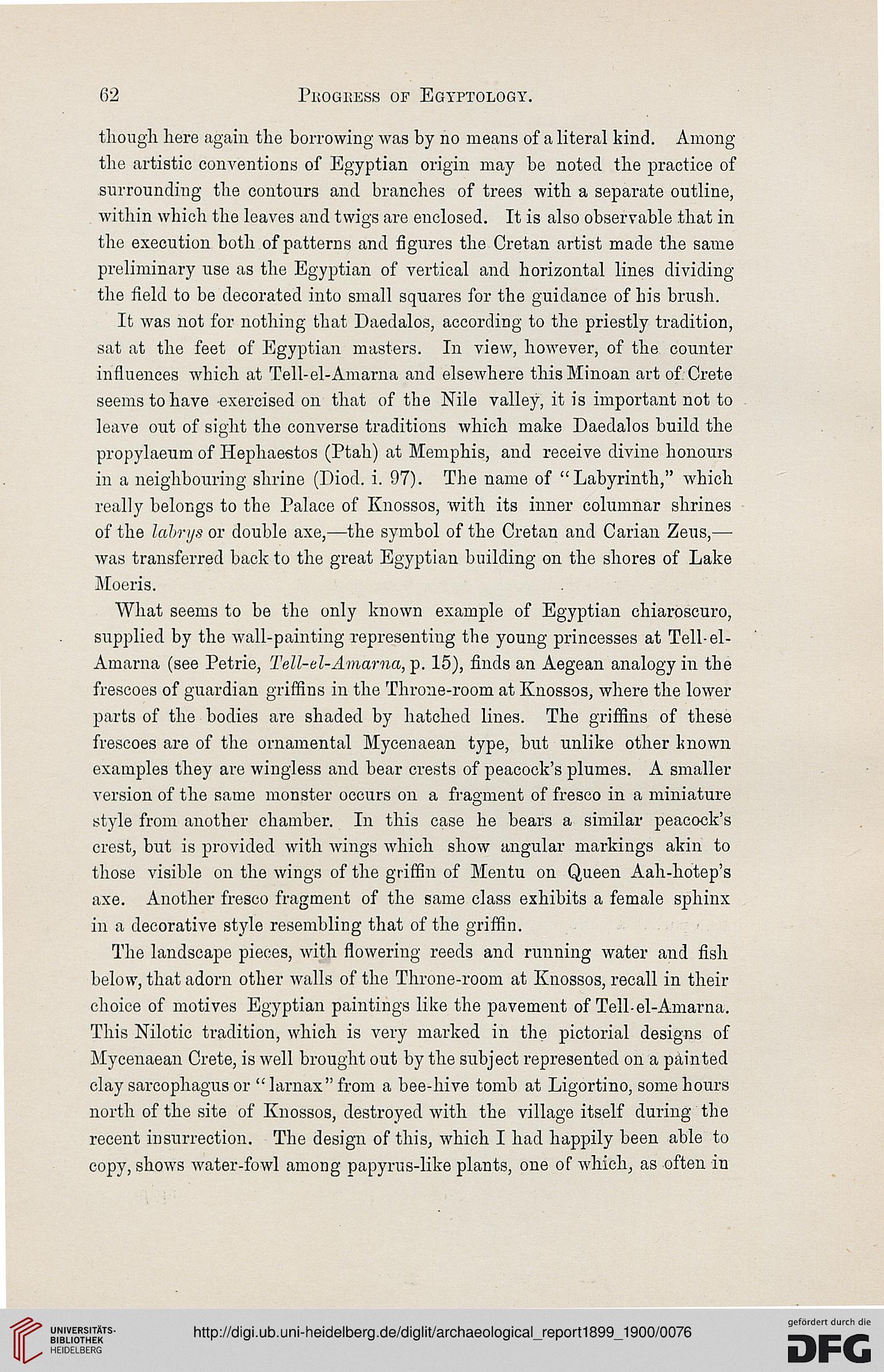62
Pkogeess of Egyptology.
though here again the borrowing was by no means of a literal kind. Among
the artistic conventions of Egyptian origin may be noted the practice of
surrounding the contours and branches of trees with a separate outline,
within which the leaves and twigs are enclosed. It is also observable that in
the execution both of patterns and figures the Cretan artist made the same
preliminary use as the Egyptian of vertical and horizontal lines dividing
the field to be decorated into small squares for the guidance of Lis brush.
It was not for nothing that Daedalos, according to the priestly tradition,
sat at the feet of Egyptian masters. In view, however, of the counter
influences which at Tell-el-Amarna and elsewhere thisMinoan art of Crete
seems to have exercised on that of the Nile valley, it is important not to
leave out of sight the converse traditions which make Daedalos build the
propylaeum of Hephaestos (Ptah) at Memphis, and receive divine honours
in a neighbouring shrine (Diod. i. 97). The name of "Labyrinth," which
really belongs to the Palace of Knossos, with its inner columnar shrines
of the lahrys or double axe,—the symbol of the Cretan and Carian Zeus,—
was transferred back to the great Egyptian building on the shores of Lake
Moeris.
What seems to be the only known example of Egyptian chiaroscuro,
supplied by the wall-painting representing the young princesses at Tell-el-
Amarna (see Petrie, Tell-el-Amarna, 15), finds an Aegean analogy in the
frescoes of guardian griffins in the Throne-room at Knossos, where the lower
parts of the bodies are shaded by hatched lines. The griffins of these
frescoes are of the ornamental Mycenaean type, but unlike other known
examples they are wingless and bear crests of peacock's plumes. A smaller
version of the same monster occurs on a fragment of fresco in a miniature
style from another chamber. In this case he bears a similar peacock's
crest, but is provided with wings which show angular markings akin to
those visible on the wings of the griffin of Mentu on Queen Aah-hotep's
axe. Another fresco fragment of the same class exhibits a female sphinx
in a decorative style resembling that of the griffin.
The landscape pieces, with flowering reeds and running water and fish
below, that adorn other walls of the Throne-room at Knossos, recall in their
choice of motives Egyptian paintings like the pavement of Tell-el-Amarna.
This Nilotic tradition, which is very marked in the pictorial designs of
Mycenaean Crete, is well brought out by the subject represented on a painted
clay sarcophagus or "larnax"from a bee-hive tomb at Ligortino, some hours
north of the site of Knossos, destroyed with the village itself during the
recent insurrection. The design of this, which I had happily been able to
copy, shows water-fowl among papyrus-like plants, one of which, as often in
Pkogeess of Egyptology.
though here again the borrowing was by no means of a literal kind. Among
the artistic conventions of Egyptian origin may be noted the practice of
surrounding the contours and branches of trees with a separate outline,
within which the leaves and twigs are enclosed. It is also observable that in
the execution both of patterns and figures the Cretan artist made the same
preliminary use as the Egyptian of vertical and horizontal lines dividing
the field to be decorated into small squares for the guidance of Lis brush.
It was not for nothing that Daedalos, according to the priestly tradition,
sat at the feet of Egyptian masters. In view, however, of the counter
influences which at Tell-el-Amarna and elsewhere thisMinoan art of Crete
seems to have exercised on that of the Nile valley, it is important not to
leave out of sight the converse traditions which make Daedalos build the
propylaeum of Hephaestos (Ptah) at Memphis, and receive divine honours
in a neighbouring shrine (Diod. i. 97). The name of "Labyrinth," which
really belongs to the Palace of Knossos, with its inner columnar shrines
of the lahrys or double axe,—the symbol of the Cretan and Carian Zeus,—
was transferred back to the great Egyptian building on the shores of Lake
Moeris.
What seems to be the only known example of Egyptian chiaroscuro,
supplied by the wall-painting representing the young princesses at Tell-el-
Amarna (see Petrie, Tell-el-Amarna, 15), finds an Aegean analogy in the
frescoes of guardian griffins in the Throne-room at Knossos, where the lower
parts of the bodies are shaded by hatched lines. The griffins of these
frescoes are of the ornamental Mycenaean type, but unlike other known
examples they are wingless and bear crests of peacock's plumes. A smaller
version of the same monster occurs on a fragment of fresco in a miniature
style from another chamber. In this case he bears a similar peacock's
crest, but is provided with wings which show angular markings akin to
those visible on the wings of the griffin of Mentu on Queen Aah-hotep's
axe. Another fresco fragment of the same class exhibits a female sphinx
in a decorative style resembling that of the griffin.
The landscape pieces, with flowering reeds and running water and fish
below, that adorn other walls of the Throne-room at Knossos, recall in their
choice of motives Egyptian paintings like the pavement of Tell-el-Amarna.
This Nilotic tradition, which is very marked in the pictorial designs of
Mycenaean Crete, is well brought out by the subject represented on a painted
clay sarcophagus or "larnax"from a bee-hive tomb at Ligortino, some hours
north of the site of Knossos, destroyed with the village itself during the
recent insurrection. The design of this, which I had happily been able to
copy, shows water-fowl among papyrus-like plants, one of which, as often in





